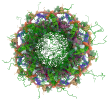Frequently Asked Questions
We currently accept integrative or hybrid models that follow the specifications defined in the IHMCIF dictionary. The dictionary is a modular extension of the PDBx/mmCIF dictionary used in the PDB archive. This dictionary supports multi-scale, multi-state, and ordered ensembles of macromolecular assemblies along with definitions for spatial restraints derived from a variety of experimental techniques.
No. Experimental structures determined using X-ray crystallography or NMR spectroscopy or Electron microscopy should be deposited through the wwPDB OneDep system.
No. Purely computational models obtained using homology modeling or ab initio methods should be deposited in the ModelArchive.
The integrative / hybrid models and the associated spatial restraints should be deposited here at PDB-Dev and should comply with the definitions in the IHMCIF dictionary.
The primary experimental data from which the spatial restraints are derived should be deposited in the corresponding experimental data repository. The following guidelines may be followed for depositing primary experimental data.
- NMR data (not accepted by the wwPDB OneDep system) can be deposited at BMRB.
- 3DEM map data can be deposited at EMDB.
- EM micrographs and 2DEM class averages can be deposited at EMPIAR.
- SAS data can be deposited at SASBDB.
- Proteomics data can be deposited at the ProteomeXchange Consortium.
The accession codes pertaining to these depositions should be included with the structure deposited in PDB-Dev.
In case there is no primary data repository corresponding to the experimental data used in the modeling, then the data should be referenced using a Digital Object Identifier (DOI). DOIs may be obtained from any provider. Zenodo is a DOI provider frequently used by PDB-Dev depositors.
The model file has to be in a format compliant with the IHMCIF dictionary. We do not accept depositions in PDB format.
We provide a standalone software library called python-ihm that supports the new IHMCIF dictionary. The library can be used to read and write data files compliant with the dictionary. Please see the documentation or some worked examples for more details.
Integrative modeling software such as IMP support the IHMCIF dictionary. Work is in progress for other integrative modeling software such as HADDOCK to support the dictionary.
The structures in PDB-Dev can be downloaded and visualized using the UCSF ChimeraX visualization software, which provides built-in support for the new IHM data dictionary. Please use the daily build for the most up-to-date visualization and use the command line option "format ihm" to visualize multi-scale structures. For more details, please refer to the news item related to ChimeraX.
Integrative structures can also be visualized using the Molstar viewer. Molstar is an open collaboration started by PDBe and RCSB PDB to provide a technology stack for data delivery and analysis tools of macromolecules. Molstar viewer is now embedded within the PDB-Dev website and structures in PDB-Dev can be visualized through Molstar from the individual entry pages. Molstar can visualize atomic as well as multi-scale structures. For more details, please refer to the news item related to Molstar.
Work is in progress to support the visualization of integrative structures using other molecular visualization tools. We recommend depositors to upload an image of their modeled structure along with the deposition.
Please visit the PDB-Dev deposition page for instructions on depositing new structures.
To cite PDB-Dev, please use one of the following references:
Vallat B et al., Acta Cryst. 2021; D77: 1486-1496, doi: 10.1107/S2059798321010871
Vallat B et al., Structure. 2018 Jun; 26(6):894-904, doi: 10.1016/j.str.2018.03.011.
To cite a structure from PDB-Dev, please use the primary citation of the structure and the PDB-Dev accession code.
Yes. Once the deposition is processed, an accession code is issued, after which the entry can either be released or kept on hold. Following wwPDB policies, entries can be placed on hold for a maximum period of one year from the date of deposition. If an entry remains unreleased at the end of the hold period, it must either be released or withdrawn.
PDB-Dev entries are updated along with the PDB archive each week on or about Wednesday 00:00 UTC (Coordinated Universal Time) with new releases, modified entries, and updated status information. Updates are prepared on the previous Friday. Citation updates and release requests should be sent to pdb-dev@mail.wwpdb.org by noon ET on the preceding Thursday to be included in the current release cycle. Entries that are complete and only require citation updates will be included in the current release; entries that require additional curation before release and requests received after an update has been packaged will appear with the following release cycle. The files in the FTP archive have the Thursday timestamp of the internal update packaging.
We have developed a new Data Harvesting System that provides a web interface for depositors to assemble all the information required for archiving integrative structures in PDB-Dev and to create a compliant mmCIF file. This includes the submission of integrative structures, associated spatial restraints and starting models used, modeling protocols and metadata information (citations, authors, software, data in external repositories, reference sequence information etc.).
The data harvesting system provides an automated mechanism for collecting diverse and heterogeneous types of integrative structures and restraint data. The system has been developed using the DERIVA scientific asset management platform and is based on the definitions in the IHMCIF dictionary and the parent PDBx/mmCIF dictionary.
A User Guide has been created with documentation regarding creating accounts and submitting data.
Users are encouraged to provide any feedback via email to pdb-dev@mail.wwpdb.org.
